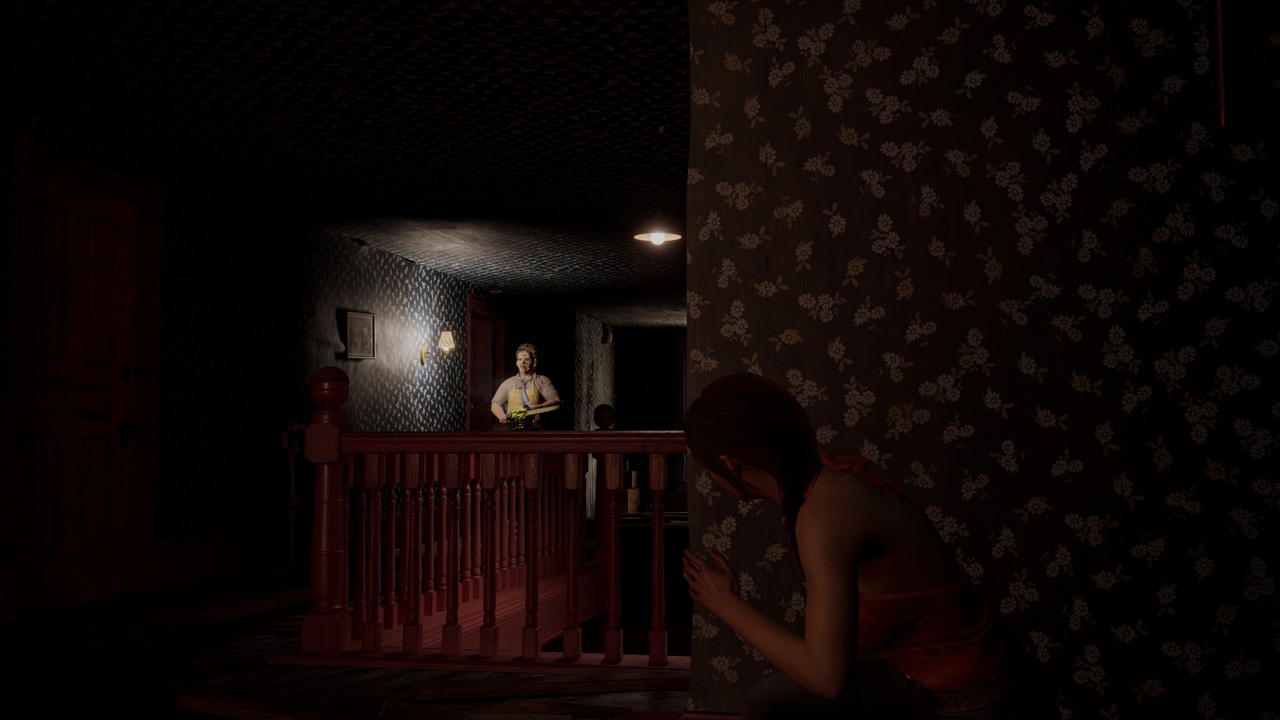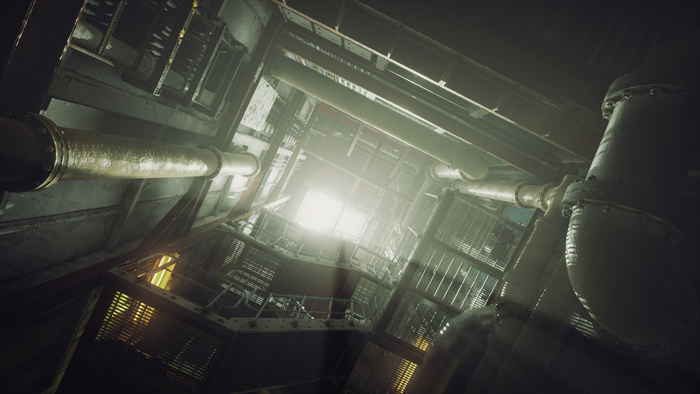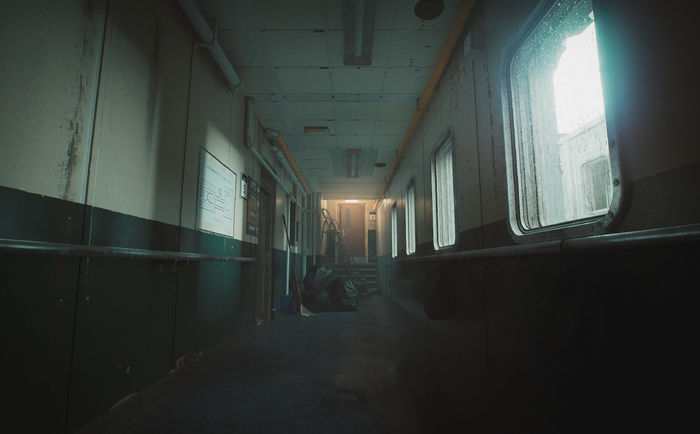Trending
Opinion: How will Project 2025 impact game developers?
The Heritage Foundation's manifesto for the possible next administration could do great harm to many, including large portions of the game development community.

Featured Blog | This community-written post highlights the best of what the game industry has to offer. Read more like it on the Game Developer Blogs or learn how to Submit Your Own Blog Post
Developers Jade Jacson, Steve Kirby and Kelvin Moore dive into horror as a genre, why we like to be scared and how game developers can exploit our deepest fears to create a wide range of scares.

What do a sun-bleached house in Texas and a rusty oil rig in the middle of the North Sea have in common?
On the surface, these locations set thousands of miles and worlds apart might seem diametrically opposed but they play host to two horror games – The Texas Chain Saw Massacre and Still Wakes the Deep – and use their unique attributes, compelling characters and eerie atmospheres to scare players.
Here, Jade Jacson – Senior Game Designer at The Chinese Room (currently working on Still Wakes the Deep) – and the petrifying pair of Steve Kirby (Lead Game Designer) and Kelvin Moore (Project Design Director) from Sumo Nottingham (who have just wrapped work on The Texas Chain Saw Massacre) dive into horror as a genre, why we like to be scared and how game developers can exploit our deepest fears to create a wide range of scares…
“Horror games and rollercoasters aren’t that dissimilar” says Jade. “In both circumstances, we willingly scare ourselves and then soak up the rush of adrenaline afterwards.”
Jade, a Senior Designer on the narrative horror game, which strands players in the middle of the North Sea with only the freezing water, an oil rig and an unknowable horror for company, continued: “I think for me, there’s a cathartic process that happens when you play horror games. You go through a huge spectrum of emotions: you’re afraid, stressed, relived, disgusted, filled with dread, sometimes even amused or brought to tears. But in games, you can experience all of them in a safe environment and can allow yourself to be vulnerable and let the fear creep in – that grants access to a huge range of very deep emotions.”

In Still Wakes the Deep, players will step into the role of Caz – an oil rig worker in the North Sea – as he navigates an unknowable horror abord the marine monolith.
So, let’s talk about fear. According to the American Psychology Association, ‘Fear’ is defined as: “a basic, intense emotion aroused by the detection of imminent threat, involving an immediate alarm reaction that mobilises the organism by triggering a set of physiological changes”.
When we’re scared, our primal instincts kick in to put our body into high-gear and prepare us for flight or flight – components of the brain buried beneath the surface work in perfect harmony to set our pulses racing, our palms sweating and to increase our awareness.
Horror games double down on all of these emotions and sensations by putting players in the driving seat – where every decision they make has consequences, and their own actions determine their fate.
“Gaming is the perfect medium for horror” says Kelvin – part of the team at Sumo Nottingham which has just wrapped work on asymmetrical multiplayer title, The Texas Chain Saw Massacre. “It’s the next level of immersion and everything you do is based on your decisions and experience. In a film, you see characters making dumb decisions and tell yourself you’d do things differently, only for you to repeat those same mistakes in a horror game when you’re put under the same level of stress.”

On the surface, the Family House in The Texas Chain Saw Massacre appears innocent... a clever disguise for the mad and macabre that awaits within...
He continued: “In The Texas Chain Saw Massacre film there’s a moment when the lead character, Sally, jumps out of a window in a desperate plea for escape. No person under a normal amount of stress would do that because of the risk of injury, but we put it in the game and have been amazed to see how many people are making the same decision despite the significant drop to their health.”
Part of the dream-dread team at Sumo Nottingham, Steve Kirby, added: “In a lot of horror films, you can spot the ending before you’re out of the first act, but games have a certain level of wild unpredictability that really adds to the chaos and stress of them. Horror game developers use heaps of false positives to trick players and push them further into the story they’re playing.”
If horror games push our limits, make us sweat and have us leaving lights on… why do we keep going back for more?
“Different styles of horror games have different tactics to keep players coming back for more.” says Kelvin. “In a multiplayer game, like Texas, there are no ends of organic scares that we as designers can’t plan for, but that players create for each other. We can predict that having good shadow-hiding mechanics will lead to good scares, but watching streamers physically hold their breath as they hide and a Family member passes by is something that never gets old.
“And because these scares happen so organically, they’re different every time. You can go into parties with friends where you can roughly identify and learn their play tactics, but there is also the option to play with strangers where every move is unpredictable and wild. There are an infinite number of playthroughs and outcomes, and that’s what keeps people playing.”
In contrast, Still Wakes the Deep puts the player in the body of protagonist Caz as they traverse through a narrative that will test the emotional scale of players. If narrative is linear, how do designers keep things scary? Jade says: “The key component to creating a good horror game is keeping things fresh. The moment you expect things to happen is the moment you stop being immersed. In Still Wakes the Deep, the ladder you use to escape might have been safe the first time… but that doesn’t mean it will be every time. It’s really important to utilise these scenarios so players never really know what to expect or what’s around the corner.

Regular people in every day settings facing something extraordinary can make the scares all the more harrowing and heartbreaking.
“We were also passionate about ensuring there was an ebb and flow of challenge for players – if you pick up a horror game where the foe is overpowering and you keep dying, then frustration takes over and the immersion is lost. Similarly, if you give your main character a powerful weapon then their chances of survival are greatly increased and some of that fear and fight to survive has gone. It’s a very fine balancing act to keep players engaged on their toes and having a good time.”
“Horror games are actually a really great medium to tell very human stories,” says Steve. “They’re a great way at digging into the human psyche and revealing the monster within. I always enjoy zombie movies because zombies are the situation, not the whole thing: zombie media is often about the psychology of humans and human nature, and the things we’ll do to survive and to cope with horrendous circumstances. Horror games are a great way at making players think.”
Still Wakes the Deep and The Texas Chain Saw Massacre may sit at different points on the ‘horror game’ genre spectrum – with one being a single-player, narrative game where players can fully embody the protagonist, and the other a multiplayer, asymmetric game where you must use your wits, stealth and nerve to stay alive… but they have plenty in common.
Steve says it’s all about setting the right Atmosphere: “If you can create an atmosphere that puts an uneasy feeling onto a player, then you’ve got a great starting point. When we were making The Texas Chain Saw Massacre, everything came to life as soon as we added elements like audio, lighting and animations into it, and the atmosphere was palpable. In The Texas Chain Saw Massacre, the atmosphere is heavy: it hangs over players regardless of which side you’re playing for – there are things at stake, and you need to fight to survive.”

Developers of The Texas Chain Saw Massacre were passionate about creating the right atmosphere from the get - go for the Victims.
Jade says it’s the use of Everyday Heroes: “In some horror media: the protagonists can be stereotypes with no personalities. They're just there to further the plot. In Still Wakes the Deep, not only does our main character Caz feel real, but hopefully our entire cast of characters does. These are not caped crusaders, they are regular people with families, friends, lives outside of their life as workers on the oil rig who come into contact with something that is so unimaginable they can't comprehend it. It's this contrast between very ordinary and realistic people and the unfathomable aspect of the unknown that we wanted to explore in our game.”
Kelvin says it’s having plenty of Near-Miss Moments: “One of the things that keep players coming back to horror games is the feeling of ‘I was this close’. If a player has been in a close encounter or a near-miss moment, then they know they’re able to escape the enemy or danger, but being put in a stressful situation can cloud your judgement and turn a near-miss into a caught and killed situation, like taking too long to manoeuvre around an obstacle, taking a wrong turn or making too much noise.”
Steve and the team at Sumo Nottingham were conscious to be clever with Pacing: “Some of the most powerful and haunting horror games are the ones that force you to sit in the fear. Games like Alien: Isolation wouldn’t be nearly as scary if players were allowed to bolt through every single level at top speed: there has to be a mechanic to slow down the player and give them breathing room in an environment with no air. Similarly, the quiet moments in a horror game can be scarier than the big, bolshy executions: hiding in a shadow in silence while a family member passes you by has all the same breath-holding horror as being chased down the driveway, in my opinion.”

Still Wakes the Deep utilises phobias to create organic scares for a breath of players. Including the fears of small spaces, the dark and of water.
Jade and the team at The Chinese Room loved the idea of digging into the brain and exploring Fears: “Setting our game on an oil rig presented us with a wealth of built-in phobias that we could explore. Including Claustrophobia (fear of small spaces), Submechanaphobia (fear of human-made objects submerged in water), Thanatophobia (fear of death), Autophobia (the fear of isolation), Thalassophobia (fear of large bodies of water), Nyctophobia (fear of the dark) and Acrophobia (fear of heights) – and probably lots of others we weren’t even aware of. Players of Still Wakes the Deep will find themselves face-to-face with scenarios that push them to their limits.”
In the Texas Chain Saw Massacre, Kelvin says you can expect Consequences: “Part of what makes horror games so exhilarating is that the player is in the driver’s seat and its their actions that determine what happens. Games that have little to no consequence don’t have the scare-factor required to keep players on their toes. There are some games that have huge anticipation but when you meet the enemy/monster/foe, nothing really happens. In Texas, we created consequences for the victims that felt very real and brutal: you don’t just die and respawn, you’re killed and out of the game… destined to watch your teammates make or break the bad decisions that led you to your fate.”
In 2023, over 1,600 horror games were released on Steam alone, an increase on all years prior. So where are developers pulling inspiration for these new and nerve-testing narratives?
“Inspiration for horror games can come from anywhere” says Kelvin. “For me, I got a lot of ideas for how characters would move and interact through watching my kids play hide and seek at the park – the genuine thrill of them finding each other was a big inspiration for the game. The irony is that since becoming a parent, I can’t watch anything where kids are on the evil side. The Conjuring? No thank you!”

Hide and seek was one of the inspirations for The Texas Chain Saw Massacre – with players being forced to use their very best stealth to survive.
“I hate ghosts” says Steve. “They’re just beyond my realm of understanding and I don’t like them. The fear of the unknown is a common fear and one often explored in horror games, and that doesn’t have to be eerie spectors or mythical monsters, it can be not understanding a person or their circumstance – something we explored in The Texas Chain Saw Massacre.”
“Working on Still Wakes the Deep is a dream come true for me as it combines two of my favourite horror concepts.” says Jade. “I love anything where everything appears fine on the surface but hides deep and dark secrets underneath. I think that kind of eerie and unsettling feeling is a great catalyst for very compelling stories and without any present scares, are really good ways to create tension. I also love things with really human-driven stories that really focus on relationships… which always ultimately makes the inevitable scare all the more harrowing and heartbreaking.”
Working on horror games can take its toll – tensions are high and they can deal with some tricky themes. From a developer perspective, Jade said: “Still Wakes the Deep has been the most interesting, beautiful, mad, sad, funny and exhausting game I have ever been a part of. We all put a piece of ourselves in it and I’m excited and afraid in equal measures to hear what people think about it. Working on a project with difficult themes can take its toll, but we have a really funny, kind and empathetic team around us and we celebrate every big and small win together. My top tips to developers working on horror games are:
Put your player hat on: It’s important to stop focussing on being a developer, and to play the game as an outsider. It can be so easy to get your head down in work and forget what the big picture is and what the end goal of the game is. Is the horror taking away from the story?

It's important for game developers to put their 'player hat' on and review the game from an outsiders perspective, to ask 'does it align with the big picture?'
Kill your darlings: Don’t be precious about something if it’s not working – being part of a close-knit team means other people are able to be more objective about your idea and can see how (or if) it aligns with the theme or story of the game.
Communication is key: Communicating when something isn’t going well is of the upmost importance when working on a project, it creates trust which ultimately leads to better teamwork. We have supported each other through every step of this process, and everyone feels like they have made a big contribution to the game rather than just being another cog in the game development machine.
For players picking up horror games, Jade says: “Be careful and keep calm. Take your time and take in the environment around you while navigating as silently as you can. Be quick on your feet and if your character is telling you to run, RUN!”
You May Also Like